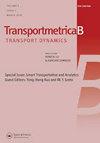变道机动纵向和横向动力学的联合建模
IF 3.4
2区 工程技术
Q2 TRANSPORTATION
引用次数: 2
摘要
本文章由计算机程序翻译,如有差异,请以英文原文为准。
Joint modelling of longitudinal and lateral dynamics in lane-changing maneuvers
This study models a lane-changing event as two behaviourally interconnected phases: ‘stay’ and ‘execution’. The model considers the ‘stay’ phase duration stochastically depending on external traffic conditions. The ‘execution’ phase is modelled as the longitudinal speed profile deployed to perform the lane change. The model comprises a Bayesian survival analysis to predict the probability of the stay duration before a new ‘execution’ phase while tackling the censoring issue of survival methods. Using naturalistic vehicular trajectory data, this paper quantifies what factors influence driver behaviour in lane-keeping and lane-changing execution. The parameter estimation results demonstrate that drivers' decisions on phase transitions are influenced by surrounding conditions, lane-changing purpose, directions, and departure lanes. The findings reveal that urgency (stemming from the purpose) and patience (satisfaction with the existing situation) are the main reasons for leaving the current lane. Adequate distances and relative speeds compared with surrounding vehicles induce or dissuade acceleration behaviour during the execution phase.
求助全文
通过发布文献求助,成功后即可免费获取论文全文。
去求助
来源期刊

Transportmetrica B-Transport Dynamics
TRANSPORTATION SCIENCE & TECHNOLOGY-
CiteScore
5.00
自引率
21.40%
发文量
53
期刊介绍:
Transportmetrica B is an international journal that aims to bring together contributions of advanced research in understanding and practical experience in handling the dynamic aspects of transport systems and behavior, and hence the sub-title is set as “Transport Dynamics”.
Transport dynamics can be considered from various scales and scopes ranging from dynamics in traffic flow, travel behavior (e.g. learning process), logistics, transport policy, to traffic control. Thus, the journal welcomes research papers that address transport dynamics from a broad perspective, ranging from theoretical studies to empirical analysis of transport systems or behavior based on actual data.
The scope of Transportmetrica B includes, but is not limited to, the following: dynamic traffic assignment, dynamic transit assignment, dynamic activity-based modeling, applications of system dynamics in transport planning, logistics planning and optimization, traffic flow analysis, dynamic programming in transport modeling and optimization, traffic control, land-use and transport dynamics, day-to-day learning process (model and behavioral studies), time-series analysis of transport data and demand, traffic emission modeling, time-dependent transport policy analysis, transportation network reliability and vulnerability, simulation of traffic system and travel behavior, longitudinal analysis of traveler behavior, etc.
 求助内容:
求助内容: 应助结果提醒方式:
应助结果提醒方式:


